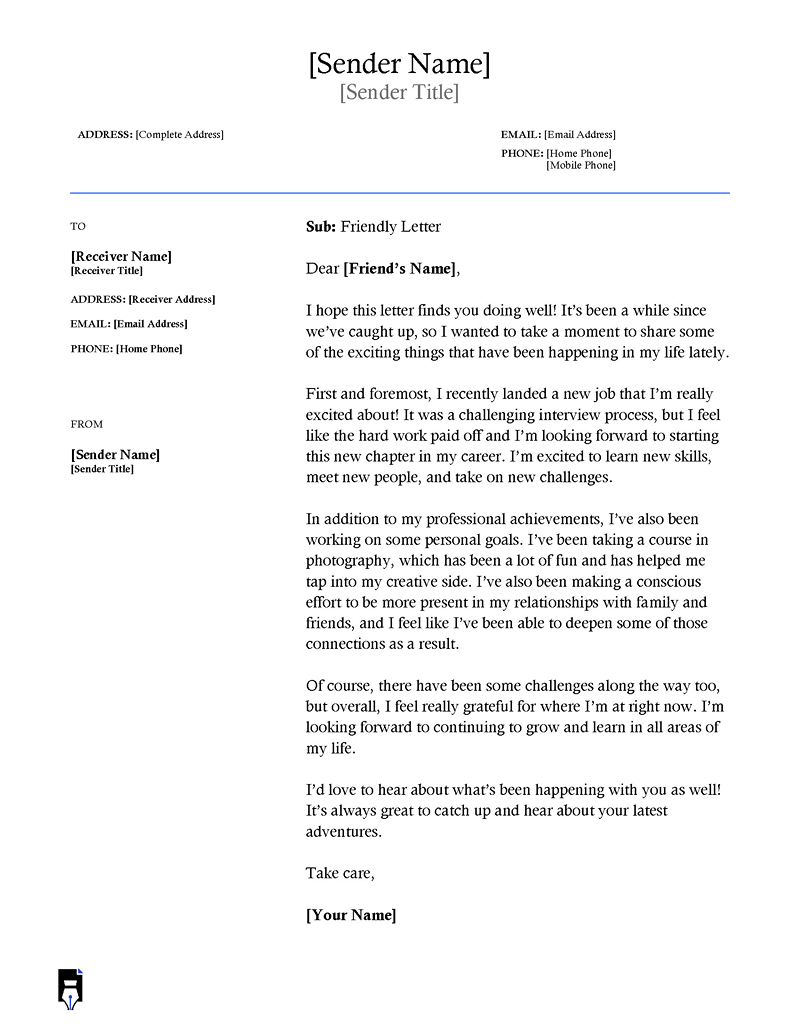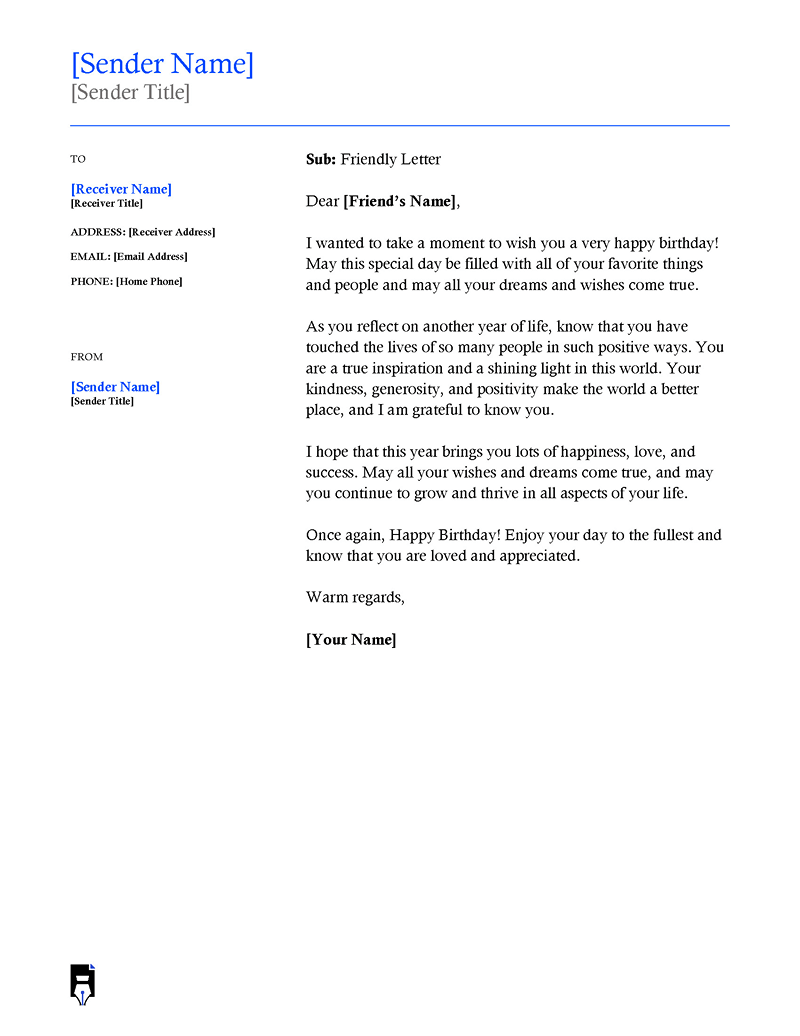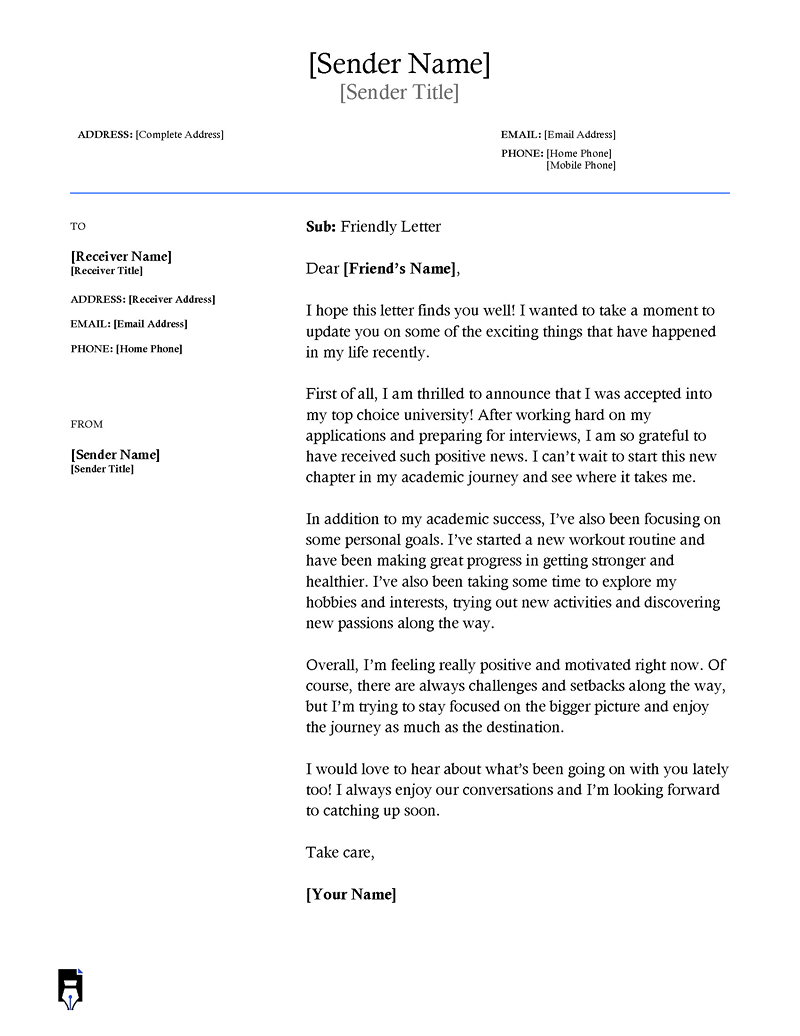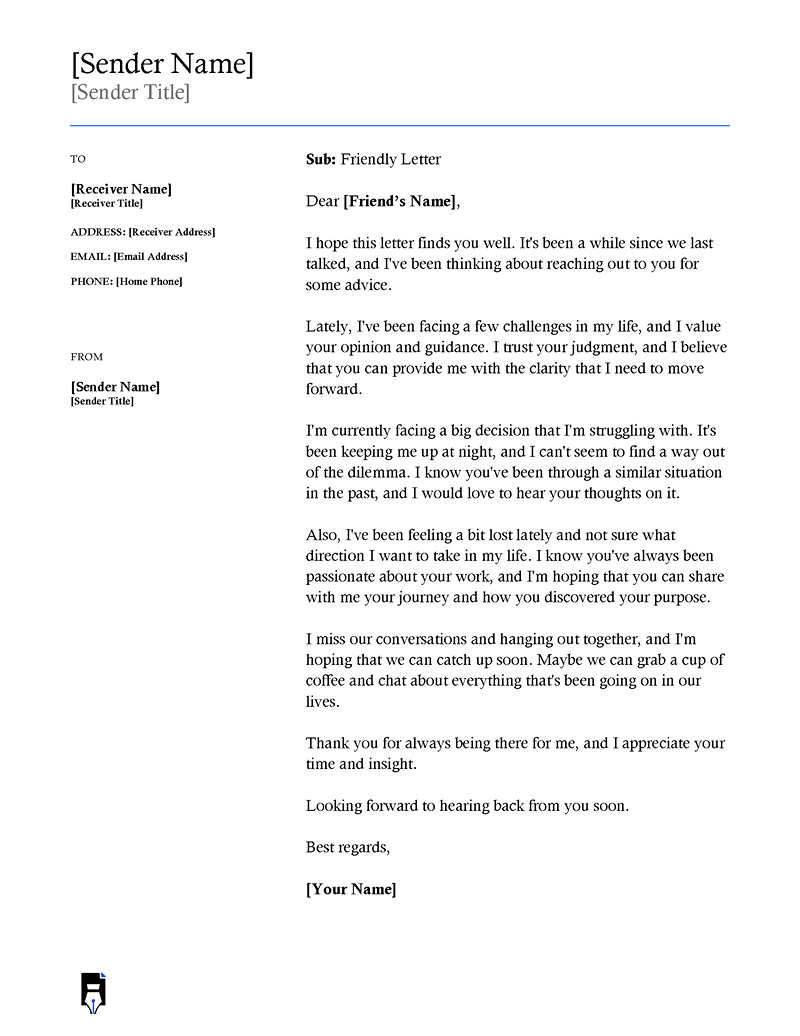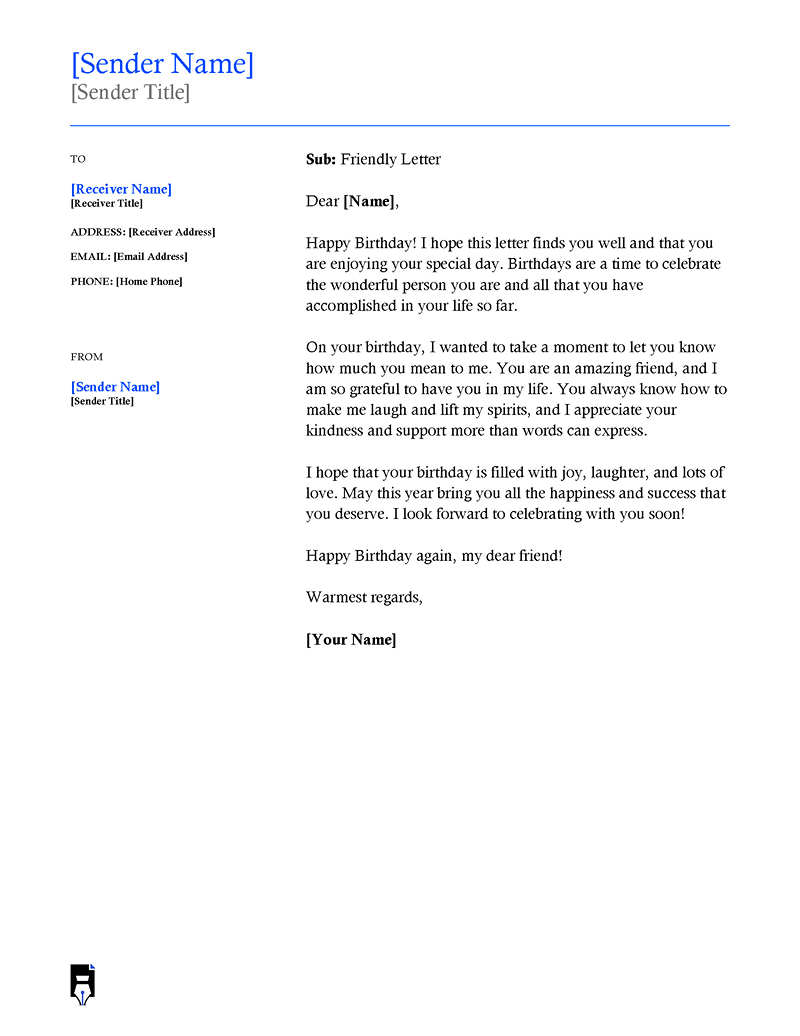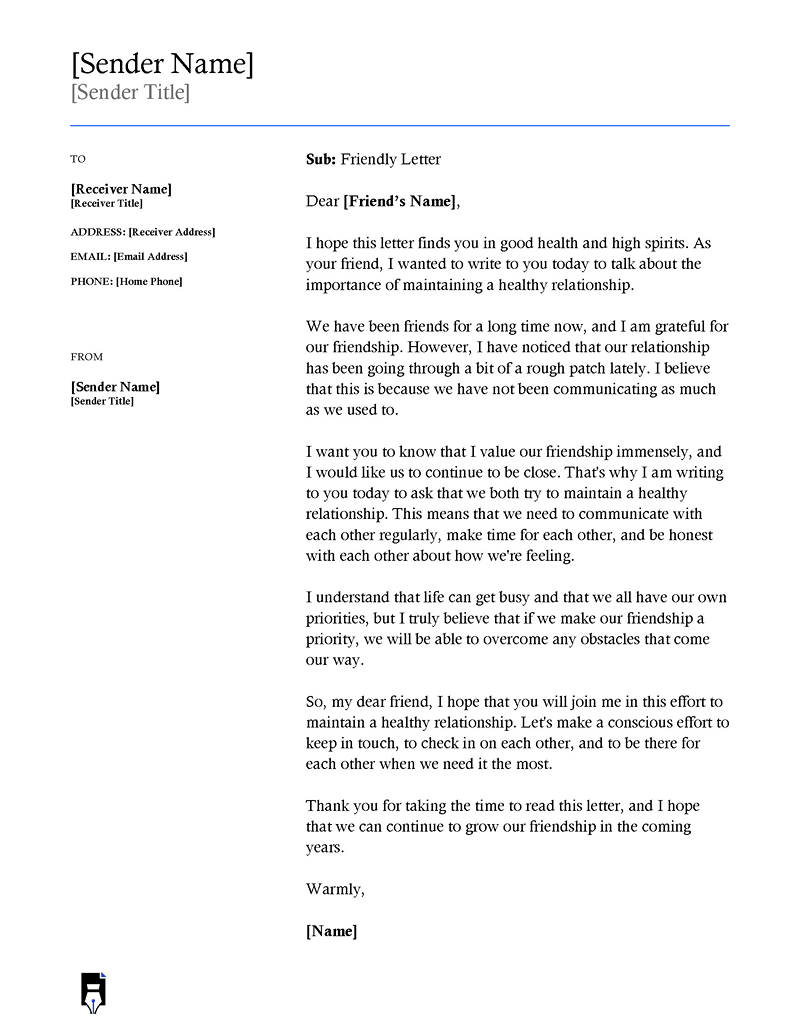A friendly letter is a simple way to stay in touch with someone you do not see often. You can use it to send birthday wishes, update someone on your achievement, ask for advice, thank someone for helping you, or remain in contact with family and friends. To ensure you build rapport and maintain relationships with the people you care about, your friendly letter needs to be written effectively. This means writing a letter that is respectful to the recipient and using a tone that is neither too formal nor too casual. A great way to achieve this is to know the intended audience beforehand, identify the letter’s purpose before writing it, and adapt your tone accordingly.
Since friendly letters are hardly ever used in the 21st century, it can be challenging to draft one that best suits your needs. This article is a comprehensive guide to writing an effective, friendly letter.
Friendly Letter Templates
You might still be stuck writing your friendly letter from scratch. If this is the case, consider using a free and downloadable template to make the writing process much more convenient. Below are professionally written and formatted templates that you can easily customize to create a letter that best suits your needs. Unlike writing from scratch, using them will save considerable effort and time.
What is a Friendly Letter?
A friendly letter is a form of communication that you use to remain in contact with someone you know on a more personal level.
Unlike formal letters, friendly letters are not usually sent to people who are your professional contacts or business associates. Instead, friendly letters typically contain information about personal matters and are often written to people you already know and have a relationship with, such as friends, relatives, peers, and acquaintances.
Generally, friendly letters are written in an informal manner. They are often written in a more conversational tone than formal letters and contain personal information. While most friendly letters take the informal writing approach, you still need to know who your recipient is and the kind of relationship you share before deciding on the right tone to use. You also need to sound respectful throughout your letter.
Note that you do not need a solid reason to address a friendly letter to someone. You can simply write one to say “hello,” inform the recipient of an important event in your life, appreciate someone who helped you in the past, gossip, convey best wishes, apologies, or congratulations, etc. You can also write them to seek advice from someone you trust or discuss other topics of mutual interest
Who Can You Write Friendly Letter To?
Recipients of friendly letters are typically people you know well or individuals with whom you have a strong relationship.
These include:
- Family members such as your aunt, grandparents, uncles, sisters/brothers who have moved away, nephews, nieces, etc.
- Friends who are not in the same city, town, or neighborhood as you
- Former or retired colleagues
- Peers
- People, such as pen pals or acquaintances, whom you have not met personally but have mutually agreed to write to each other from time to time. Pen pal relationships are primarily based on the letters you exchange. These relationships typically aim to have fun while still learning from one another.
How to Write Friendly Letter in 7 Easy Steps
You should consider several things while drafting a friendly letter to ensure that it is received and perceived as intended. Your letter should be as brief and concise as possible. If you are looking for the right way to structure your friendly letter, consider the eight steps outlined below:
Begin with some pleasantries
A friendly letter’s first paragraph should sound warm, lighthearted, and intriguing to the recipient. You can achieve this by using a few lines to compliment the letter’s recipient, say an extended hello, tell a joke that you both understand, acknowledge a personal achievement, reference the season, or inquire more deeply about the recipient’s life.
For example,
Hello Grandma,
I am so happy that you are finally back home after your extended stay at the hospital. I missed you so much. I hope you are feeling better and ready for your big birthday party. I am thinking of a nice present to give you. I can’t wait to see you again!
Share news and personal details
The second paragraph should contain a brief update on your recent activities, significant events, or any other personal details you feel comfortable sharing with the recipient. Consider being specific when sharing these details such that the recipient can relate. Moreover, avoid creating an airbrushed picture of your life, as the recipient may feel you are not genuine. Try as much as possible to portray your life realistically.
For example:
I am doing my best at work, and thanks to a new opportunity, I have found a cash gift of RM10,000! It has been years since I received my last financial windfall, and I am looking forward to spending the money on some personal investments and taking you on a weekend getaway when I come home.
Share how you have been doing
Your letter’s recipient would feel more connected to you if they knew how you have been doing since you last communicated. A good way of revealing these details to the recipient is by sharing something that provides a sense of significance without sounding overly self-promotional.
You only need to ensure that what you share is interesting enough for the reader and that it will pique their curiosity.
For example:
Since the last time we spoke, I have had to change jobs. My new job is very challenging, but I enjoy it a lot. I am learning a lot and hope to be promoted within a few years. Since my workplace is closer to aunt Rachael’s home, I have been passing by her house more regularly, and she seems to be doing well. She had a baby recently, and the little boy is just too cute! I have attached his pictures for you.
Discuss topics of mutual interest
It is also essential to talk about something you both enjoy. If you share a similar interest or activity, mentioning it in this part of the letter might be a good idea. This could be as simple as mentioning a movie you enjoyed together, a book you both read, or any other activity that makes you think of one another and leaves you with fond memories.
For example:
Remember when we went to the theatre to watch Interstellar? I never knew I would enjoy, let alone love, a movie with so much Science Fiction. I had so much fun watching it with you, and I look forward to watching more movies like that with you.
Include a wrap-up
It is imperative to end your friendly letter on a high note. This gives the reader a pleasant feeling of resonance and connection with you. To conclude your letter effectively, consider reiterating your purpose for writing it and thank the reader for their time. You can also briefly discuss your plans or encourage your recipient to write back if you need a response.
For example:
I hope to see you again soon. Thanks again for being such a fantastic grandma. I love you so much.
End with a sign-off
You will want to avoid leaving the reader ‘hanging’ at the end of your letter. Therefore, making a final remark or including a short closing line is crucial before you sign off your name.
The most appropriate sign-off statements to use in your friendly letter include the following:
- We will be in touch soon. Bye for now
- With love
- Thank you so much for your love and support
- Looking forward to staying friends forever
- Best friends
- Good luck with everything. You deserve the best in life
- Best wishes to you always
- You are the best
- Good luck with everything you do. I promise to always be there for you
- Lots of love
This section can be formatted as the example provided below:
With lots of love,
Your Granddaughter April.
Include a postscript
The postscript is an optional section to add at the end of your friendly letter. It is a way to add a final touch to your letter’s content without distracting from the purpose of the letter. You can simply write a joke as your PS or skip it altogether.
For example:
PS: I hope I didn’t give you too many details about my personal life or ruin your birthday present surprise.
Friendly Letter Sample
13th December 2022
Hey Bob,
I have been thinking of writing you this letter for a long time, and I hope you take your time to read it. We have not seen each other for some time now, but we mustn’t lose touch. You were such an inspiration to me when I was young and growing up in the orphanage. I remember how you used to tell me that only hard-working people get success in life. That has been in my mind throughout my adult life. Maybe that is why I work so hard even today to earn a good living and maintain a decent lifestyle.
Let me briefly update you on my life since we last met. Life has been pretty good for me, but there have also been some ups and downs. Recently, I have had to relocate from the city since the apartment rent became too much for me to bear. I live in Miami now, but I plan to move back to Los Angeles soon because that is where all my friends, including you, live.
I am also planning to start a firm that will work on developing software and building large-scale data processing systems. I know this ambitious project requires so much hard work and devotion, but I hope it will be rewarding. I am sure your expert advice will come in handy for me.
I heard you recently married a woman you met in your volunteer programs. I am extremely happy for you and hope you will be delighted together. Not sure if this is a rumor, but a mutual friend told me that you are expecting your first child. If this is true, then congratulations on becoming a father!
Please give my regards to your entire family and tell them I am very proud of their achievements. You have always been kind to me, and I wish you a great life filled with happiness and prosperity. I cannot wait to talk to you soon, and I look forward to a pleasant conversation.
Best regards,
Your childhood friend, Harry.
Do’s and Don’ts
When drafting your friendly letter, there are specific considerations that you should consider to ensure your communication is effective in making the recipient feel valued and appreciated.
These considerations include the following:
Do’s
Helpful tips to practice when writing a personal letter to family members, friends, acquaintances, or peers include the following:
- It is crucial to handwrite it because it makes your letter feel personal. Most people prefer this type of communication, and they will appreciate the effort you put into writing the letter.
- Always add a personal greeting at the beginning of the letter. This is essential in establishing a personal connection.
- You can write a friendly letter to let someone know you are thinking about them or thank them for their support, but don’t make it too long or complicated. Only include details that directly relate to the topic you are writing about.
- Keep your letter short and sweet. Limit it to a single page and only include the most relevant details.
- If your letter is addressed to an older person, consider using large fonts to compensate for their poor eyesight.
- Add exciting anecdotes or facts to your friendly letter to pique the reader’s interest and curiosity.
- Always show concern for your recipient’s interests by discussing topics of mutual interest rather than making a letter about yourself.
Don’ts
The things to avoid while writing your friendly letter include the following:
- Avoid making your message too long and complicated. A long letter tends to confuse readers, and they may lose interest in reading it altogether. Five hundred or fewer words are sufficient for friendly letters.
- Make it a point to avoid including unnecessary punctuation, such as exclamation points.
- Do not include legal jargon or formal language in your friendly letter. Your recipient needs to know that you are writing a personal letter, not a legal or business document.
Bottom Line
Personal or friendly letters have always been used to engage with loved ones and friends. However, technology and resulting advancements have made it easier to contact family and friends electronically via text messages or social media. This has continuously led to friendly letters seeming old-fashioned and out of style, but they are the best way to remain in contact with friends and loved ones more personally.
Friendly letters are arguably one of the most popular forms of non-business communication, and they are very effective in promoting connections and maintaining relationships. You can use them to express gratitude and concern over various circumstances or make amends for mistakes you have made in the past. If you are thinking of the best way to communicate with someone important in your life more personally, this writing guide will prove very beneficial to you.
